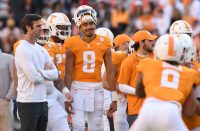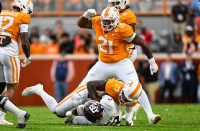This time of year you can usually tell who Tennessee’s best and/or most popular players are going to be not by fall camp talking points, but jersey sales. I’d expect to see plenty of #15’s on display this fall, and maybe a #12 or #2 if a front-runner emerges in the quarterback battle.
To my knowledge I’ve never seen an offensive lineman’s jersey for sale, for the Vols or for anyone. It is the least sexy and least marketable position group on the field. But, at Tennessee and likely far beyond, you cannot do great things without a great offensive line.
For Team 121, if you were ranking the units? The offensive line would be at the top. It doesn’t generate much noise in August. But when the line leads the way, it can generate something far more memorable in September.
Here are the starting offensive lines (pulled from Tennessee’s media guide, listed from LT to RT) for each of Tennessee’s most memorable teams of the last 30 years. You’ll notice a trend.
1989 SEC Champions: Charles McRae, Tom Myslinski, John Fisher, Eric Still, Antone Davis
1990 SEC Champions: McRae, Myslinski, Fisher, Doug Baird, Davis
Consider the overall talent on these two teams: in the 1990-1992 NFL Drafts, Tennessee had 11 players selected in the first three rounds. Those names include future Pro Bowl selections Dale Carter and Carl Pickens, first round selections like Alvin Harper and Chris Mims, and absolute program legends like Reggie Cobb and Chuck Webb. But of those 11 in the first three rounds in this three year span, the two who were drafted highest were offensive tackles Charles McRae and Antone Davis, going 7th and 8th in the 1991 NFL Draft. Why were Andy Kelly and the Cobb-Webb attack so dominant? These boys up front didn’t hurt.
1995 #2 Coaches’ Poll: Jason Layman, Trey Peterson, Jeff Smith, Bubba Miller, Robert Poole
Smith and Miller had started since they were freshmen, Layman since he was a sophomore. They joined Trey Peterson to make for four seniors up front along with junior Robert Poole (plus tight end Scott Pfeiffer). Layman, Miller, and Smith all earned first-team All-SEC honors in 1995, and Layman was a second round draft pick. If you compare the ’95 and ’96 offenses, the quarterback and skill positions are identical (Manning, Graham, Kent, Nash). But in conference play the ’95 squad averaged an absurd 38.9 points per game, compared to a merely really good 34.4 in ’96. The Vols rebuilt the offensive line with youth in 1996, then this happened:
1997 SEC Champions: Chad Clifton, Spencer Riley, Trey Teague, Mercedes Hamilton, Cosey Coleman
1998 BCS Champions: Clifton, Hamilton, Riley, Coleman, Jarvis Reado
1999 BCS at-large: Clifton, Fred Weary, Riley, Coleman, Josh Tucker
Only a select group started all three seasons in Tennessee’s most successful three-year run: Jamal Lewis, Raynoch Thompson, Dwayne Goodrich, and three offensive linemen: Chad Clifton, Spencer Riley, and Cosey Coleman. This group lost away from home to #2 Florida, #2 Nebraska, #4 Florida, Clint Stoerner’s karma, and #3 Nebraska. They beat everyone else, winning two SEC titles and the 1998 national championship. Trey Teague earned first-team All-SEC in 1997; Cosey Coleman did that twice in ’98 and ’99 with All-American honors to boot in ’99. He played seven years in the NFL and won a Super Bowl ring with Tampa Bay. But I’d put Chad Clifton’s career up against any offensive tackle: in college and the NFL he protected the blind sides of Peyton Manning, Brett Favre, Aaron Rodgers, and Tee Martin en route to a national championship.
2001 SEC East Champions: Reggie Coleman, Fred Weary, Scott Wells, Jason Respert, Will Ofenheusle
Weary was still around two years later and, other than Cosey Coleman, is the highest-drafted offensive guard in program history. No season’s losses were more fluky or painful than 2001’s, but this line had little to do with them. They did have a hand in the season’s biggest win: Travis Stephens and Jabari Davis get remembered, but this group took on one of Florida’s most talented teams and paved the way for them. I was a student at UT at the time, and Will Ofenheusle might still be the biggest person I’ve seen up close.
2004 SEC East Champions: Michael Munoz, Rob Smith, Jason Respert, Cody Douglas, Arron Sears
True freshmen quarterbacks need friends, and there’s no better friend than a strong offensive line. In the 2004 Florida game they helped produce one of my favorite drives of all time: 12 plays, 80 yards, four different ball carriers, all runs for Tennessee’s first touchdown. Sears would go on to be a second round draft pick, and though the NFL never worked out for Munoz and Respert, they were two of Phillip Fulmer’s biggest prizes in recruiting: Munoz is the fifth-highest rated prospect the Vols signed since 2000, Respert 12th. Munoz was a first-team All-American in 2004; knee injuries cost him on draft day.
2007 SEC East Champions: Eric Young, Anthony Parker, Josh McNeil, Chris Scott, Ramon Foster
Ramon Foster has been so successful for the Steelers for so long, I’d forgotten he was an undrafted free agent. The up-and-down 2007 Vols had issues with youth on defense, surrendering 145 points in three regular season losses. But this line was spectacular with David Cutcliffe at the controls: they surrendered a national-best four sacks all year on 538 passing attempts, helping Erik Ainge turn unheralded receivers Lucas Taylor and Austin Rogers into 1,000 yard threats.
What does this mean for 2017? There is, of course, no guarantee. A great offensive line can’t do it by themselves (see: 2013) and skill position injuries can cost the most talented groups (see: 2002). But recent history shows every time the Vols have a big year, it comes behind a talented, veteran offensive line.
There’s a lot we cannot say for sure about Team 121. But a talented, veteran offensive line – give or take a five-star freshman – could lead the way. And when that happens at Tennessee, big things tend to follow.



